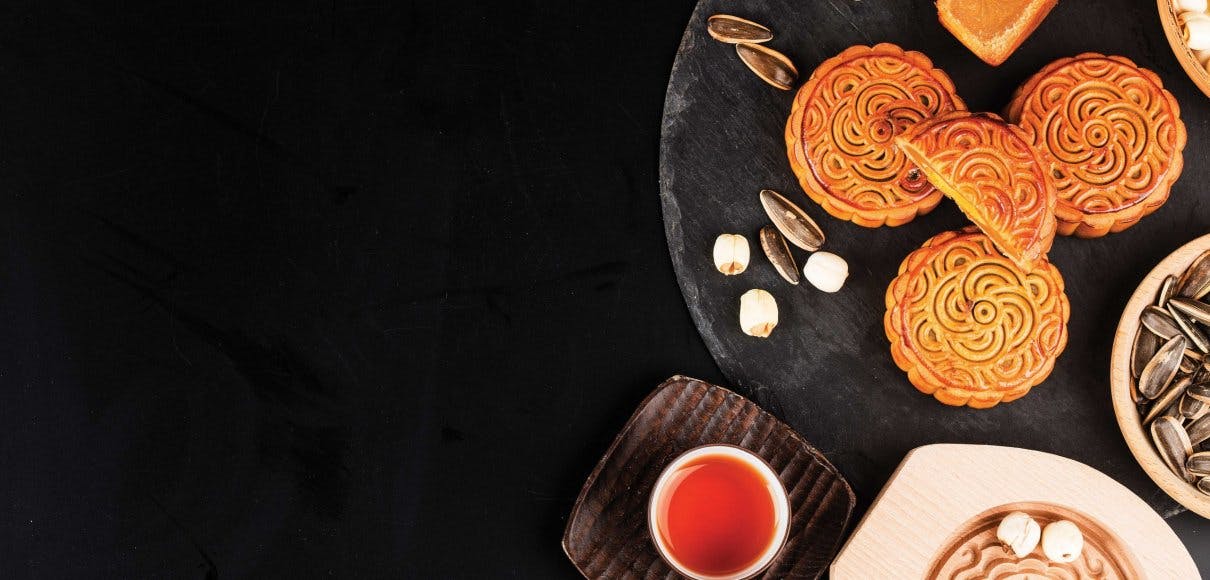Xu Bian
Assistant Professor of Chinese
CHINA
IN CHINA, THE SECOND-MOST IMPORTANT holiday (after New Year) is the mid-autumn festival, which occurs on the 15th day of the eighth lunar month, typically falling in September or October of the Western calendar. On this day, the moon is at its fullest and brightest, symbolizing reunion.
“Even today, I send my parents a box of high-quality moon cakes to enjoy.” — Xu Bian
Family members gather to celebrate, appreciate the moon’s beauty, and eat moon cakes. Some moon cakes are savory, others are sweet, depending on the region. These round cakes are cut into pieces that equal the number of family members. Fillings might include nuts, red bean paste, egg yolk, meat, or fruit. In some families, making moon cakes is part of the season’s tradition, along with fashioning paper lanterns lit with candles to float in rivers or hang from trees.
XU: There are many ethnic groups in China with their own traditions, but in the Han culture, the autumn festival is one of the most important celebrations. Everyone tries to go home to visit family, observe the full moon, hear elders tell fairy tales about the holiday, and eat moon cakes.
Nowadays people often buy moon cakes from the bakery, but in the past, they were made at home. Where I grew up in northeastern China, the moon cakes were hard and tasteless, so I didn’t care for the autumn festival because I didn’t like the cakes! When I moved to southeastern China to attend college, I found a wide variety of delicious moon cakes. I began to like the holiday, and even today, I send my parents a high-quality box of moon cakes to enjoy.
RECIPE:
Mooncakes
Servings: 12 to 14 miniature mooncakes
Red Bean Filling
1 cup dry red or azuki beans
2/3 cup sugar (or more, to taste)
6 tablespoons coconut oil, or another solid fat like lard
Filling preparation
Place the beans in a pot and cover them with 1 to 2 inches of water. Soak for at least two to three hours, or ideally overnight.
If you are concerned about any dirt or imperfections on the beans, after soaking them, blanch the beans by bringing the water and beans to a boil, then immediately drain and rinse the beans.
Next, combine the beans with 3 more cups of water in a pot and bring it to a boil over high heat. Once the water begins to boil, reduce the heat to low and let the beans simmer without stirring for about one and a half to two hours. After an hour, test a bean by mashing it with a spoon or your fingers. If it splits into two halves, keep cooking. If it smushes easily, it’s done simmering. As the water boils down, you will need to add just enough water to keep the beans submerged. You can add ½ cup after about 30 minutes of boiling, then another ½ cup every 15 to 20 minutes until the beans are done.
Drain the beans and add them to a food processor or blender, along with the sugar, and process on high until smooth. If you do not have a food processor or blender, drain the beans, add sugar directly to the pot, and keep cooking over low heat, mashing as you would mash potatoes until the mixture is smooth.
Add the bean paste and coconut oil in a pan and stir until the fat in incorporated, then cook over medium heat for three to five minutes, stirring consistently, until the paste becomes glossy and forms a soft dough that sticks to the spoon in one mass. Remove from heat and chill until ready to use.
Mooncakes
1/4 cup golden syrup (like Lyle’s)
1/2 teaspoon Lye water (Lye water neutralizes the acidity in the golden syrup and helps to turn the mooncakes golden during baking. You can make alkaline or Lye water by mixing 1/8 tablespoon of baking soda into 8 fluid ounces of purified water.)
2 tablespoons vegetable oil
1/2 cup all-purpose flour
1/2 cake flour (1/2 cup all-purpose flour may be substituted)
2 cups chilled red bean filling
1 egg
A splash of milk
Preparation
Mix together all ingredients except for the red bean filling, egg, and milk,and gently knead just until they come together into one mass. Take care not to knead vigorously. Cover with plastic wrap, refrigerate and let rest for 45 minutes to an hour. This will help relax the dough and make it more elastic, so it won’t break or crack as easily when shaping and wrapping with the dough.
Preheat oven to 350 degrees Fahrenheit. Divide the filling into 12 equal pieces and shape each into a ball. Each ball of filling should be about 2 tablespoons to 2 ½ tablespoons — roughly the size of a golf ball (about 33 to 34 grams).
For each mooncake, scoop about a tablespoon of dough and roll it between two pieces of parchment paper to about 3 inches in diameter.
Flour hands lightly and place a ball of filling in the center of each dough circle and fold up the dough around the ball. It likely will not cover the whole ball at once. Gently push, press, and squeeze the dough, holding the ball securely in your palm, until the dough gradually covers the filling. (The firmer the filling, the easier this will be.)
If it really won’t squeeze over the filling, don’t worry — just pinch off another small piece of dough, roll it out, and use it to patch the ball.
Place the mooncake ball into a mooncake press* and turn it upright on your surface. Press the plunger down until you feel resistance. Lift the mooncake press off the table and use the plunger to push the mooncake out. Place on a Silpat or parchment-lined baking sheet while you make the rest of the cakes. If it’s a hot day, you may want to place these in the fridge to keep their form while you finish folding.
Bake for eight minutes. Remove the mooncakes from the oven and let them cool on the baking sheet for about 10 minutes. Make the egg wash by whisking together one egg and a splash of milk. Brush each mooncake with the egg wash, then bake the cakes for another 10 to 15 minutes, or until golden brown on top and fragrant.
Let cool completely on cooling racks. Store in an airtight container for two days to “release” the oil — the mooncakes will become shiny, soft, and supple, and it’s at this point that they are meant to be eaten.
*You will need a miniature (50 gram) mooncake press for this recipe.




